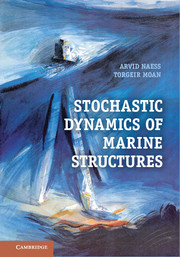Book contents
- Frontmatter
- Contents
- Preface
- 1 Preliminaries
- 2 Dynamics of Single-Degree-of-Freedom Linear Systems
- 3 Dynamics of Multi-Degree-of-Freedom Linear Systems
- 4 Finite Element Method
- 5 Stochastic Processes
- 6 Variance Spectrum
- 7 Environmental Loads
- 8 Random Environmental Processes
- 9 Response Spectrum
- 10 Response Statistics
- 11 Statistics for Nonlinear Problems
- 12 Short-Term and Long-Term Extremes
- 13 Dynamic Load Effects for Design Checks
- 14 Equations of Motion
- 15 Numerical Solution Techniques
- 16 Monte Carlo Methods and Extreme Value Estimation
- A Integrals
- B Poisson Process
- C Statistical Moments and Cumulants
- References
- Index
12 - Short-Term and Long-Term Extremes
Published online by Cambridge University Press: 05 February 2013
- Frontmatter
- Contents
- Preface
- 1 Preliminaries
- 2 Dynamics of Single-Degree-of-Freedom Linear Systems
- 3 Dynamics of Multi-Degree-of-Freedom Linear Systems
- 4 Finite Element Method
- 5 Stochastic Processes
- 6 Variance Spectrum
- 7 Environmental Loads
- 8 Random Environmental Processes
- 9 Response Spectrum
- 10 Response Statistics
- 11 Statistics for Nonlinear Problems
- 12 Short-Term and Long-Term Extremes
- 13 Dynamic Load Effects for Design Checks
- 14 Equations of Motion
- 15 Numerical Solution Techniques
- 16 Monte Carlo Methods and Extreme Value Estimation
- A Integrals
- B Poisson Process
- C Statistical Moments and Cumulants
- References
- Index
Summary
Introduction
For true probabilistic design of load-carrying members of offshore structuresthat have to withstand the effects of the environmental forces generated bywind, waves, and current, it would be necessary to provide a simultaneousprobabilistic model of all three load-generating sources. As an alternative, asimplified conservative approach may be applied. According to NORSOK N-003(2007), the 100-year environmental condition can be represented by the 100-yearwave and mean wind speed, and the 10-year current.
In the following sections, the focus is on the three commonly used approaches forcalculating characteristic values of extreme load effects due to wave forces forULS design checks, viz.,
the design wave approach
the design sea state approach
the full long-term approach
Design Wave Approach
For the design of offshore structures where the load effects to be considered areprimarily of a quasistatic nature, the extreme load effect for ULS design checkcan be estimated by the so-called 100-year wave approach. This is understood tomean a wave with a wave height H(100) being exceededon the average only once every 100 years. Equivalently,H(100) can be interpreted as the wave heightthat is exceeded during a period of one year with a probability of10−2, cf. Section 10.8.
Estimation of load effects according to this format would in practice proceed asfollows. (1) The design wave height is established on the basis of availabledata relevant for the offshore location in question.
Information
- Type
- Chapter
- Information
- Stochastic Dynamics of Marine Structures , pp. 275 - 286Publisher: Cambridge University PressPrint publication year: 2012
